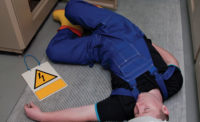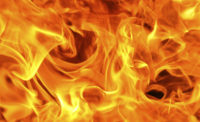Companies related to manufacturing take up most of the top-ten list of cited industries. Fabricated metal product manufacturers topped the list, with 272 citations and fines of $328,400. Machinery manufacturers were slapped with 272 citations and $328,400 in fines. In third place: merchant wholesalers of durable goods, with 93 citations and $148,562 in penalties. Next came wood products manufacturing facilities (88 citations, $82,874); food manufacturers (86 citations, $164,848); plastics and rubber products manufacturing companies (81 citations, $116,207); repair and maintenance (68 citations, $53,691); primary metal manufacturing (67 citations, $87.102); transportation equipment manufacturing (64 citations, $100,239); and printing and related support activities (63 citations, $69,063).
Engineers, electricians, and other professionals who work directly with overhead lines, cable harnesses, and circuit assemblies are among those at risk for being exposed to electrical hazards, but they’re not alone.Citation case studies
Some OSHA inspections that lead to citations are routine, others are prompted by tragedy. Such was the case in Guntown, Missippi in October of 2014, when an untrained worker suffered a fatal electrocution while he was disconnecting wiring on a saw at H.M. Richards, Inc., a furniture manufacturer. OSHA investigators determined that if 46-year-old maintenance worker, Raymond Marvin Reece, had been provided with the required electrical safety training, he would have known that the equipment he was working with was still “live” and contained enough electricity to kill him.
In addition to citations related to training, the company – which employs about 900 workers at the Guntown facility – was cited for not ensuring the electrical disconnect switch could not be turned back on before performing work; exposing employees to electrical shock and burns due to unmarked ground conductors; and allowing damaged wiring on a fan.
Another electrical tragedy resulted in citations against Seldat Distribution, Inc., in Dayton, New Jersey. OSHA initiated an investigation on Sept. 11, 2014, in response to a referral from the South Brunswick Fire Marshall reporting that an employee was electrocuted by an improperly wired, powered conveyer system.
Among the electrical hazards OSHA found at the facility: improper installation and use of listed equipment; wiring that was not protected from abrasions; unused openings in electrical panels that were not closed; the use of flexible cords and cables in lieu of fixed wiring, and a lack of strain relief for cords and cables.
“Electrical hazards are one of the most common issues impacting workers, and the dangers involved are hardly a secret to employers. This was a preventable tragedy,” said OSHA’s Patricia Jones.
Two more examples:
• Richardson Milling, Inc. in Dawn, Texas was cited by OSHA for electrical hazards including: use approved electrical equipment in areas with dangerous levels of combustible dust; the use of an unapproved forklift truck whose exposed conductor cables could potentially ignite combustible dust; and not properly guarding belts and pulleys in order to prevent amputations.
• Workers at Covanta Energy Bristol, Inc. who were performing testing on live electrical parts were not given adequate training and protective clothing to perform the task safely. For those and other violations, the Connecticut trash-to-energy company received 16 citations and $80,100 in fines. OSHA’s Terence McEvily noted that the company “needlessly exposed its employees to the hazards of electrocution.”




